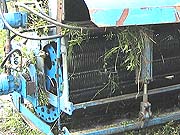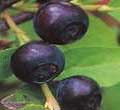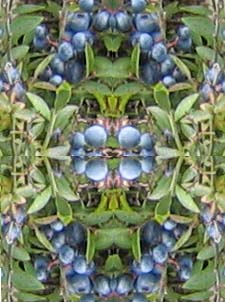 |
Mr. Blueberry of South Ohio |
 |
 |
Mr. Blueberry of South Ohio |
 |
![]()
![]()
![]()
![]()
![]()
![]()
![]()
![]()
![]()
![]()
![]()
![]()
![]()
![]()
![]()
![]()
![]()
![]()
![]()
![]()
![]()
![]()
![]()
![]()
![]()
![]()
![]()
![]()
![]()
![]()
![]()
![]()
![]()
![]()
![]()
![]()
![]()
![]()
![]()
![]()

|
Pictures on the left show the new blueberry harvester developed by
the Province of Nova Scotia. Each tractor can do about two acres
a day. These machines came from Oxford, N.S. They will spend
about 9 days in his area them head home to harvest the crops in their area.
About 75 percent N.S. of present production comes from Cumberland County.
(S)
Only about 1% of the berries come from the Yarmouth area. In 1993
over 30,000,000 pounds of berries were harvested in Nova scotia. Map
John plans on expanding his fields, with the purchase of about 10 more acres in the Kempt area. At best he has produced about 6000 pounds of berries per acre. It is an iffy prospect and that yield could easily be cut to less than half by adverse conditions. |
  Mummy
berry is probably the most commonly known disease of blueberry. It is caused
by the fungus Monilinia vacinii-corymbosi. The most conspicuous symptom
of the disease is the mummification of infected berries. Picture to the
left are mushroom-like apothecia that germinate from mummy berries on the
ground in the spring. These contain ascospores which cause shoot blight.
(S)
For more information go to BLUEBERRY
DISEASES IN MICHIGAN. Mummy
berry is probably the most commonly known disease of blueberry. It is caused
by the fungus Monilinia vacinii-corymbosi. The most conspicuous symptom
of the disease is the mummification of infected berries. Picture to the
left are mushroom-like apothecia that germinate from mummy berries on the
ground in the spring. These contain ascospores which cause shoot blight.
(S)
For more information go to BLUEBERRY
DISEASES IN MICHIGAN.
The disease can be controlled by spraying, but there is a very narrow window of 72 hours in which this must be done. Picture on the right shows small pinkish white berries among the mature. These are what we refer to as mummy berries. Once infected a field must be sprayed every year. Only specific chemicals can be used on a field. Berries are checked before processing and if banned chemicals are detected the whole shipment is rejected. |
| Videos of: | |
| 1 | John & Richard |
| 2 | Matthew Surette on raker |
| 3 | Raking Machine |
|
Blueberries are native to North America with large stands in the Maritimes and coastal New England. In 1976, the high bush berries began to be cultivated in Ontario. Surprisingly, acid rain has stimulated the growth of natural stands of low bush berries in some inland areas by reducing the pH level of the soil. (S)
Freezing Blueberries
Scientific classification
 In
the United States the name huckleberry is often used for blueberry.
While the two fruits are similar in appearance and flavor, the huckleberry
which is a drupe has a 10-celled ovary, each cell (drupelet) normally containing
a seed large enough to be conspicuously noticeable when the whole fruit
is eaten. Blueberries, in contrast, contain many seeds so small as not
to be noticeable when the fruit which is a berry is consumed. Only blueberries
are a cultivated crop, but quantities of huckleberries are harvested from
native plants. The huckleberry plant is a shrub, to 6 feet, with small,
entire oval leaves. Fruits are borne in small clusters. Individual fruits
are generally one-third inch or less in diameter, mainly blue to black
in color, sweet or slightly tart when ripe.(S) In
the United States the name huckleberry is often used for blueberry.
While the two fruits are similar in appearance and flavor, the huckleberry
which is a drupe has a 10-celled ovary, each cell (drupelet) normally containing
a seed large enough to be conspicuously noticeable when the whole fruit
is eaten. Blueberries, in contrast, contain many seeds so small as not
to be noticeable when the fruit which is a berry is consumed. Only blueberries
are a cultivated crop, but quantities of huckleberries are harvested from
native plants. The huckleberry plant is a shrub, to 6 feet, with small,
entire oval leaves. Fruits are borne in small clusters. Individual fruits
are generally one-third inch or less in diameter, mainly blue to black
in color, sweet or slightly tart when ripe.(S)
|
|
|
| 1. | Natures | |
| History | History of Nova Scotia Blueberry industry | |
| www.wildblueberries.com | So blue, so sweet, so distinctly different, lowbush WildBlueberries are the healthy little berries from Maine, Atlantic Canada and Quebec. | |
| . | Natures # 1 antioxidant | Recent USDA studies show that Wild Blueberries are a tasty way to eat right and stay healthy. Scientists at the Jean Mayer USDA Human Nutrition Research Center on Aging ranked blueberries #1 in antioxidant activity compared with 40 other commercially available fruits and vegetables. |
| Blueberries in Nova Scotia | The most common species of blueberry harvested in Nova Scotia is the wild low bush type, known scientifically as Vaccinium angustifolium. | |
| www.blueberrystore.com. | Something special has been created to help you celebrate Canada's long relationship with its favouriteberry. | |
| ORGANIC BLUEBERRY CULTURE | On most sites, blueberries are relatively free of disease and insect pests, but weeds are an ever present problem. | |
| Blueberry Recipes | Top 50 links from google | |
| Homemade Blueberry Wine | Lee Etherington | winemaking.com | finevinewines.com | | |
| A few odd ones | Blueberry Hamburgers | blueberry-soup recipe | blueberry butter | |
| 2. | A Fictitious Story | When they got on the land and up the hill they saw blueberries the size of melons. |
Return to South Ohio Homepage
Return to Yarmouth Villages

Blueberry page Background